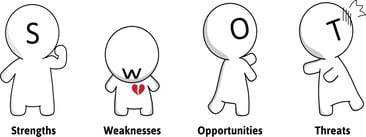P rint service providers: Have you taken the time lately to analyze your competition? It might not be the shop across town anymore, but a business in another state, or even overseas, that is soliciting business from your customers. Even if you have done competitive research before, you may need to update it. Much has changed since the pandemic started.
rint service providers: Have you taken the time lately to analyze your competition? It might not be the shop across town anymore, but a business in another state, or even overseas, that is soliciting business from your customers. Even if you have done competitive research before, you may need to update it. Much has changed since the pandemic started.
Why Bother?
A competitive analysis allows you to measure your company against the competition. The process creates an environment that can reveal gaps in the marketplace or highlight areas in your own operation that could benefit from improvement.
Researching competitors gives you the knowledge necessary to develop effective marketing strategies for your own business while simultaneously pointing out threats posed by competitors whose activities may target your customers.
This is an ideal time for this exercise. Print service providers everywhere are re-evaluating how they do business. Those that relied on walk-in traffic have shifted to online tools that allow customers to order, configure, and buy print products online. Some are succeeding, others are struggling. You can learn valuable lessons about what or what not to do by assessing the efforts of others who have already blazed this trail.
Competitive analysis can indicate what is important to print customers now, and how print vendors are responding. COVID-19 has also affected customer businesses, and their priorities may have adjusted. Certain vertical markets have an increased need for print while others have contracted. Speed may be more important than price, or perhaps innovative financing plans make print buying more reasonable at a time when customer cash flow has slowed.
To round out your situational assessment, talk to your customers. Find out what is important to them now and how they expect their businesses to change in the next few years.
How to Do a Competitive Analysis
Competitor research shouldn’t be an intimidating thought. You can learn much with a modest investment of time and effort. For those who want to dig deeper, outside experts or specialized tools are available.
Start with a simple review. The wealth of information and insight to be gained with just a few hours of work may surprise you. Here are some basic steps that produce the data necessary to determine an effective strategy.
1. Identify the Competitors
You may be tempted to search on Google by entering the business names for known competitors, but try entering your own business name first. Scroll to the bottom of the knowledge panel on the right side of the search results page. Google will display related searches for local businesses. Results may vary depending on your search settings and the browser you use.
 To widen the search geographically, use keyword phrases related to what you do. Be as specific as possible. The ads and entries in the search results will identify other print companies that also offer those services. If you don’t see your company listed in the organic search results, your site is lacking enough relevant content. You may need to publish more items like blog articles that reference your keywords.
To widen the search geographically, use keyword phrases related to what you do. Be as specific as possible. The ads and entries in the search results will identify other print companies that also offer those services. If you don’t see your company listed in the organic search results, your site is lacking enough relevant content. You may need to publish more items like blog articles that reference your keywords.
2. Record the Details
From your research, choose three or four of your most direct competitors. These will be companies that offer the same products and services as your company and are courting the same customers. Use a chart or spreadsheet and list each of the companies in columns at the top of the page. Then populate the rows below with details like strengths and weaknesses of each competitor, their target markets, strategies for online and offline marketing, products and services they emphasize, etc.
3. Compare to Your CompanyNotice the differences between your organization and competing print service providers. Also notice what the high-performing companies are doing. Look at websites, publications, and social media activities. Perhaps one company publishes consistently to their blog with original informational content, while another leans heavily on social media. Some printers work hard to develop email subscriber lists, while for others it’s just an afterthought. You may get some ideas to try for yourself.
Pay attention to how your competitors do their marketing. Are they using video? Do they actively interact with others on social media? What about webinars or live events? Which websites seem most likely to prompt visitors to take the next step in the buying process?
4. Do a SWOT Analysis
SWOT (Strengths, Weaknesses, Opportunities, and Threats) is a way to see how you match up with your competitors. Do a SWOT analysis on each competitor and on your own company. The results will suggest actions you can take to capitalize on competitor weaknesses and emphasize your strengths. Look at your own weaknesses and devise ways to minimize their impact. Because of the analysis work you’ve done, your opportunities will be clear.
How to React?
Analysis won’t change anything. You must take action.
The moves you make will depend on the information and insight you’ve gained from the competitive analysis exercise. Perhaps the answer is delivering work faster, optimizing your workflow to trim costs, or begin a campaign to expand on services for an underserved niche. Maybe you need to retrain your salespeople or invest in new hardware or software.
The print business has always been highly competitive. To succeed, customers must have a reason for working with you instead of the shop down the street or across the country. But you can’t distinguish your company from the rest unless you understand how you match up. Set aside a few hours to assess your competition. Your improved knowledge of the competitive marketplace can guide you through challenging times.


